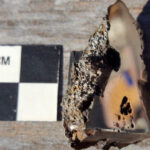Using data from NSF’s Karl G. Jansky Very Large Array (VLA), the Atacama Large Millimeter/submillimeter Array (ALMA) and NASA’s Juno spacecraft, two teams of astronomers have examined the distribution of the trace gas ammonia in the atmosphere of Jupiter, and the gaseous sodium chloride and potassium chloride in the atmosphere of Io in order to investigate their characteristics and infer properties of Io’s volcanoes.

This image shows Jupiter’s South South Temperate Belt. The image was taken on October 29, 2018 as Juno performed its 16th close flyby of Jupiter. On this occasion, Juno was about 21,600 miles (34,700 km) from the planet’s cloud tops. Image credit: NASA / JPL-Caltech / SwRI / MSSS / David Marriott.
“Some of Jupiter’s biggest mysteries remain unsolved despite decades of observations,” said University of California, Berkeley astronomer Chris Moeckel and colleagues.
“Questions about its formation environment, the source of energy for its atmosphere, and the distribution of trace gases within said atmosphere remain as open-ended as ever.”
“The vastness of the planet and its atmosphere, coupled with the short time scales on which the atmosphere evolves, implies that a global understanding of the planet requires coordinated observations across many different frequencies.”
To study the giant planet’s atmosphere at different depths, the astronomers combined observations made with instruments aboard NASA’s Juno spacecraft, in orbit around Jupiter, with observations with the VLA.
They collected data about the distribution of ammonia at different atmospheric levels to help determine the vertical structure of the Jovian atmosphere.
These observations needed to be sufficiently detailed to combine Juno’s long wavelength observations with the VLA’s high-frequency resolution to understand vertical transport in the atmosphere.
The spatial resolution of the ground-based VLA observations was comparable to that of the instrument aboard the spacecraft orbiting the planet.
These observations produced the highest-resolution radio image yet made of Jupiter.
“Radio observations allow to disentangle some of the mysteries that Jupiter still holds for us,” the researchers said.
“A combined analysis of VLA and Juno observations allow us to constrain the vertical structure of the atmosphere; however, this is not unique due to the fact that radio waves originate from a range of pressures.”
The team’s results will be published in the Planetary Science Journal.

The volcano-laced surface of Jupiter’s moon Io was captured in infrared by the Jovian Infrared Auroral Mapper (JIRAM) imager aboard NASA’s Juno spacecraft as it flew by at a distance of was about 80,000 km (50,000 miles) on July 5, 2022. Brighter spots indicate higher temperatures in this image. Image credit: NASA / JPL-Caltech / SwRI / ASI / INAF / JIRAM.
“Jupiter’s moon Io, the innermost of the Galilean moons, is the most volcanically active body in our Solar System due to intense tidal forces from its 4:2:1 orbital resonance with Europa and Ganymede,” said University of California, Berkeley Erin Redwing and colleagues.
“Strong internal heating from tidal forcing on Io results in extreme volcanic activity; there are over 400 known volcanoes on Io’s surface, approximately 150 of which had thermal activity detected during the Galileo mission.”
“Io’s atmosphere is primarily sulfur dioxide, thin and tenuous, and is replenished both by plume outgassing from its many active volcanoes, as well as sublimation of surface frost deposits.”
“As such, Io’s atmosphere is not uniform across its surface, but rather is highly spatially localized around active volcanoes and over surface frost deposits at latitudes <30-40 degrees.”
Using the ALMA data, the authors studied the trace gases of sodium chloride and potassium chloride in the atmosphere of Io.
They found that these compounds are largely confined in extent and are at high temperatures, indicating that they, too, are expelled by volcanoes.
They also found that these compounds are in different locations from where sulfur dioxide is emitted, which suggests that there may be differences in the subsurface magma or in the eruptive processes between the volcanoes that emit sulfur dioxide and those that emit sodium chloride and potassium chloride.
“Assuming these gases are volcanic in origin, these ratios imply a magma temperature of 1,300 K, such that the magma will preferentially outgas potassium chloride over sodium chloride,” they said.
Their findings were published in the Planetary Science Journal.
_____
Chris Moeckel et al. 2022. Ammonia Abundance Derived from Juno MWR and VLA Observations of Jupiter. Planet. Sci. J, in press; arXiv: 2209.03513
Erin Redwing et al. 2022. NaCl & KCl in Io’s Atmosphere. Planet. Sci. J 3 (238); doi: 10.3847/PSJ/ac9784


